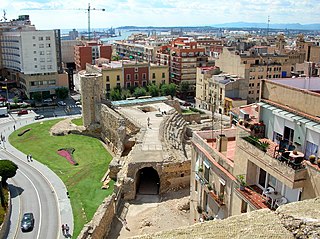
Tarragona is a coastal city and municipality in Catalonia (Spain). It is the capital and largest town of Tarragonès county, the Camp de Tarragona region and the province of Tarragona. Geographically, it is located on the Costa Daurada area on Mediterranean shore.

Tarragona is a province of eastern Spain, in the southern part of the autonomous community of Catalonia. It is bordered by the provinces of Castellón, Teruel, Zaragoza, Lleida and Barcelona and by the Mediterranean Sea.

Tarraco is the ancient name of the current city of Tarragona. It was the oldest Roman settlement on the Iberian Peninsula. It became the capital of Hispania Tarraconensis following the latter's creation during the Roman Empire.

Hadrian's Villa is a UNESCO World Heritage Site comprising the ruins and archaeological remains of a large villa complex built around AD 120 by Roman Emperor Hadrian near Tivoli outside Rome.

Augusta Emerita, also called Emerita Augusta, was a Roman colonia founded in 25 BC in present day Mérida, Spain. The city was founded by Roman Emperor Augustus to resettle Emeriti soldiers from the veteran legions of the Cantabrian Wars, these being Legio V Alaudae, Legio X Gemina, and possibly Legio XX Valeria Victrix. The city, one of the largest in Hispania, was the capital of the Roman province of Lusitania, controlling an area of over 20,000 square kilometres (7,700 sq mi). It had three aqueducts and two fora.

Gamzigrad is an archaeological site, spa resort and UNESCO World Heritage Site of Serbia, located south of the Danube river, in the city of Zaječar. It is the location of the ancient Roman complex of palaces and temples Felix Romuliana, built by Emperor Galerius in Dacia Ripensis. The main area covers 10 acres (40,000 m2).

The Arc de Berà is a triumphal arch some 20 km north-east of the city of Tarragona, Catalonia, Spain, close to Roda de Berà. This monument is part of the Archaeological Ensemble of Tarraco, which was added to the UNESCO's list of World Heritage Sites in 2000. It stands on the line of what was the Via Augusta, now the N-340 road.
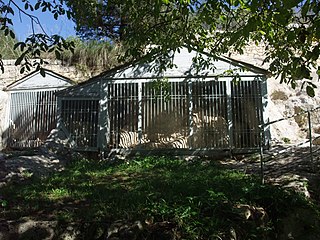
The Santoni are a collection of statues carved into a rock face near Palazzolo Acreide, the ancient Akrai, in Sicily.

The Thracian horseman is a recurring motif depicted in reliefs of the Hellenistic and Roman periods in the Balkans—mainly Thrace, Macedonia, Thessaly and Moesia—roughly from the 3rd century BC to the 3rd century AD. Inscriptions found in Romania identify the horseman as Heros and Eros and also Herron and Eron, apparently the word heros used as a proper name. He is sometimes addressed in inscriptions merely as κύριος, δεσπότης or ἥρως. Inscriptions from Bulgaria give the names Salenos and Pyrmerula/Pirmerula.

Daorson was the capital of the Illyrian tribe of the Daorsi. The Daorsi lived in the valley of the Neretva River between 300 BC and 50 BC. They came very early into contact with Greek traders acquiring many facies of Greek civilization, and the town acquired a certain degree of Hellenization. After the peace treaty with Rome in 168/167 BC, the Daorsi minted their own coins.
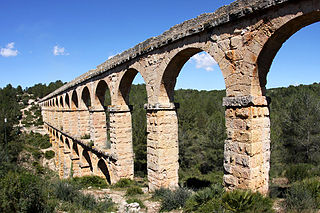
The Ferreres Aqueduct, also known as the Pont del Diable, is an ancient bridge, part of one of the Roman aqueducts that supplied water to the ancient city of Tarraco, today Tarragona in Catalonia, Spain. The bridge is located 4 km north of the city and is part of the Archaeological Ensemble of Tarraco.
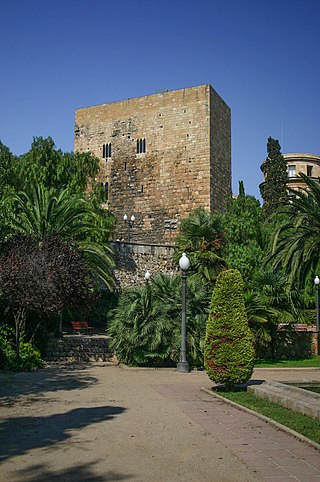
The provincial forum of Tarraco is a Roman archaeological site in Tarragona, Catalonia, Spain, encompassing an area of 18 ha. Together with other Roman remains in the city it makes the Archaeological Ensemble of Tarraco, which was listed in the UNESCO World Heritage Sites in 2000.

The Romanization of Hispania is the process by which Roman or Latin culture was introduced into the Iberian Peninsula during the period of Roman rule.
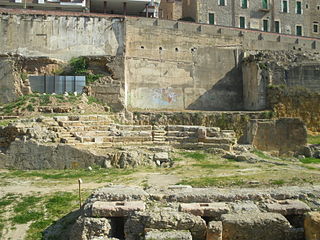
The Roman theatre of Tarraco was a Roman theatre built in Tarraco in the time of Augustus in the area of the local forum and the port, the planners took advantage of the steep slope of the hill to build part of the seating.

Archaeological Ensemble of Tárraco is inscribed as UNESCO world heritage site since 2000. It is situated in Tarragona.

The Jajce Mithraeum, or Jajački Mithraeum is a temple (Mithraeum) dedicated to the Persian invisible sun god, Mithra. It was rediscovered in an archaeological dig in 1931 in Jajce, Bosnia and Herzegovina.
The villa of "Els Munts" is a residential roman villa built during the 2nd century C.E. The villa is located 12 km away from Tarraco in the municipality of Altafulla in Spain. Scholars have regarded the villa of Els Munts as noteworthy for its mosaics and exceptional state of preservation. As a part of Tarraco, the villa of Els Munts is a UNESCO World Heritage site.


















